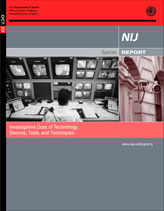|
View in browser: https://www.crime-scene-investigator.net/newsletter/0122.html
|
||
|
JANUARY 2022 | ||
|
Welcome to the January 2022 Crime Scene Investigator Network Newsletter
| ||
|
This Month's Featured Resource on the Crime Scene Investigator Network Website
|
||

This special report is intended to be a resource to any law enforcement personnel (investigators, first responders, detectives, prosecutors, etc.) who may have limited or no experience with technology-related crimes or with the tools and techniques available to investigate those crimes. It is not all inclusive. Rather, it deals with the most common techniques, devices, and tools encountered. Technology is advancing at such a rapid rate that the information in this special report must be examined in the context of current technology and practices adjusted as appropriate. It is recognized that all investigations are unique and the judgment of investigators should be given deference in the implementation of this special report. |
||
|
New CSI and Forensic Job Announcements
|
||
|
The most comprehensive listing of Crime Scene Investigation and Forensic To be notified of job openings as they are posted, follow us on Twitter: Job Posting Alerts |
||
|
Crime Scene Technician
Escambia County Sheriff's Office, Pensacola, Florida, USA Final Filing Date: January 17, 2022 Performs office and fieldwork related to the crime scene investigation, collecting, examining, preserving, documenting, preparing, and review of physical evidence and providing courtroom testimony as required. <View complete job listing> |
||
|
Crime Scene Specialist
Austin Police Department, Austin, Texas, USA Final Filing Date: January 19, 2022 Responds to crime and accident scenes, evaluates the scene and conducts searches for evidence utilizing disciplines related to crime scene investigation. Measures and/or photographs crime scenes, evidence, etc. Documents, collects, packages, preserves, and processes evidence. <View complete job listing> |
||
|
Crime Scene/Property Evidence Specialist
Menifee Police Department, Menifee, California, USA Final Filing Date: January 29, 2022 Performs a variety of technical and specialized duties related to crime scene investigation and property and evidence management; identifies, diagrams, photographs, collects, transports and preserves evidence from crime scenes; receives, processes, stores, safeguards, delivers, releases, and disposes of police property, evidence and supplies; <View complete job listing> |
||
|
Forensic Trainee
Omaha Police Department, Omaha, Nebraska, USA Final Filing Date: February 1, 2022 This is trainee work in the field of criminal identification. Work involves receiving on-the-job training regarding all tasks performed by Forensic Investigations and performing less complex, repetitive tasks, as well as testifying in court regarding evidence gathering. <View complete job listing> |
||
 |
||
|
Firearms and Tool Marks Examiner
St. Louis County Police Department, St. Louis, Missouri, USA Final Filing Date: January 23, 2022 Examines bullets, bullet fragments, cartridge cases, firearms and related evidence found at crime scenes or in the possession of suspects. Discharges weapons to produce spent ammunition for test firing characteristics and to facilitate microscopic comparisons of bullets and spent shells. Enters test shots and evidence from crimes into the National Integrated Ballistic Information Network (NIBIN). <View complete job listing> |
||
|
Toxicologist, Forensic Scientist I
North Carolina Department of Justice, Greensboro, North Carolina, USA Final Filing Date: January 5, 2022 The Forensic Scientist I will complete prescribed Toxicology training requirements before beginning casework. The Forensic Scientist I performs casework on toxicology evidence seized by Law Enforcement officers in the course of Driving While Impaired (DWI) investigations. <View complete job listing> |
||
|
Forensic Scientist (Latent Print)
Henderson Police Department, Henderson, Nevada, USA Final Filing Date: Open until filled You will analyze, compare and evaluate latent prints/footwear impressions, utilize AFIS databases, write reports of findings, testify in court as an expert witness; and perform other related duties as assigned. <View complete job listing> |
||
|
Deputy Coroner
Northampton County Coroner, Nazareth, Pennsylvania, USA Final Filing Date: March 31, 2022 Conducts a systematic scene investigation, to assist with determining the cause and manner of death. Takes custody of the remains in accordance with the prescribed protocol and procedure. Performs initial on scene examination of the remains, takes photographs and collects information relevant or related to the cause and manner of death. Conducts external examination of bodies and collects body fluids for the purposes of toxicology testing as may be required in individual cases. <View complete job listing> |
||
|
Search for more job listings in Crime Scene Investigations and Forensics To be notified of job openings as they are posted, follow us on Twitter: Job Posting Alerts |
||
|
Other Resources on the Crime Scene Investigator Network Website
|
||
|
Not Subscribed to this Newsletter?
|
||
|
If you are not subscribed to this newsletter, you may subscribe with this link: SUBSCRIBE via email |
||
|
To Unsubscribe
|
||
|
To unsubscribe from future e-mail alerts, please click here: UNSUBSCRIBE Copyright ©2022 Crime Scene Resources, Inc. Crime Scene Investigator Network |


